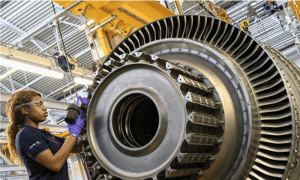Trailblazing technology: MTU Aero Engines produces parts by additive manufacturing
by MTU from press release
| 2014/03/13 | 698 words
| AVIATION WORLD NEWS | MAINTENANCE / MRO
Additive manufacturing technology is rapidly spreading from one industry sector to the next. In the field of aero engine construction, Munich-based MTU Aero Engines has achieved a breakthrough: As one of the first companies to use the new technique, MTU produced components for production engines this past May. These parts - borescope bosses for the PurePower® PW1100G-JM engine, the Pratt & Whitney engine to power the A320neo – are made by selective laser melting, or SLM. “With this move, MTU has reaffirmed its leadership in delivering innovation; for we are using one of the most advanced technologies there is to produce parts for one of the most advanced engines in the world, the geared turbofan,” explains Chief Operating Officer Dr. Rainer Martens.
The low-pressure turbine for the PW1100G-JM geared turbofan (GTF) engine will be the first turbine ever to come equipped with borescope bosses produced by additive manufacturing processes. The bosses form part of the turbine case and allow the blading to be inspected at specified intervals for wear and damage using a borescope. “We used to make these parts by casting or by milling them from the solid,” explains Martens. Now they are being manufactured by SLM. With this technique, the first step is to slice up a 3D CAD model of the component to be produced. A laser then builds up the solid equivalent of the model layer by layer from a powdered material, the layer thickness being 20 to 40 micrometers. The powder particles are locally melted and fused together. At the moment, the borescope bosses are still being produced in small quantities only. Things will be different from 2015 on: Once production of the PW1100G-JM engine to power the A320neo ramps up, MTU’s production volumes, too, will go up substantially.
Germany’s leading engine manufacturer began looking into options to use additive manufacturing about ten years ago, for the benefits of the innovative approach are too compelling to ignore: The processes allow complex components that are extremely difficult, if not impossible to manufacture using conventional methods to be produced with only small amounts of material and few tools. The technology opens the door to entirely new designs, appreciably cuts development, production and lead times, and brings down production costs. “Additive manufacturing is particularly suitable for producing parts in materials that are difficult to machine, as, for example, nickel alloys,“ according to Dr. Karl-Heinz Dusel, Senior Manager, Rapid Technologies at MTU in Munich.
“We started off making tools and development parts with a simple geometry,” the production expert explains. In a second phase, SLM parts were produced as substitutes for existing ones, such as spray nozzles and grinding wheels for use on the shop floor. At around the same time, work on the GTF engine borescope bosses began to pick up speed. Plans are now to redesign and produce lightweight components in a next step. Dusel expects additive manufacturing methods to prove a boon especially with complex components, conceivably bearing housings and turbine airfoils.
Says Chief Operating Officer Martens: “We are currently pressing on with SLM, giving its further development top priority in numerous technology projects and programs.” For instance, as part of its activities pursued under Clean Sky, the largest aeronautical research program ever launched in Europe, MTU is manufacturing a seal carrier using the SLM technique; the inner ring with integral honeycombs will be installed in the high-pressure compressor and contribute to a weight reduction, lighter-weight designs being one of the key objectives in engine and aircraft construction.
For Martens, this much is clear: His strategy has worked out pretty well. “We didn’t start with complex components right away, but began with relatively simple engine parts, such as borescope bosses. We kept moving forward step by step, gathering more and more experience in the process. This approach is now paying off, for we are among the first to actually use additive manufacturing processes to make parts that go into production engines. Working on the PW1100G-JM engine for the A320neo, we’ve learned how the technology works to support production, and can now adopt the process for other components and engine types as well, the basic structures being the same.”
The low-pressure turbine for the PW1100G-JM geared turbofan (GTF) engine will be the first turbine ever to come equipped with borescope bosses produced by additive manufacturing processes. The bosses form part of the turbine case and allow the blading to be inspected at specified intervals for wear and damage using a borescope. “We used to make these parts by casting or by milling them from the solid,” explains Martens. Now they are being manufactured by SLM. With this technique, the first step is to slice up a 3D CAD model of the component to be produced. A laser then builds up the solid equivalent of the model layer by layer from a powdered material, the layer thickness being 20 to 40 micrometers. The powder particles are locally melted and fused together. At the moment, the borescope bosses are still being produced in small quantities only. Things will be different from 2015 on: Once production of the PW1100G-JM engine to power the A320neo ramps up, MTU’s production volumes, too, will go up substantially.
Germany’s leading engine manufacturer began looking into options to use additive manufacturing about ten years ago, for the benefits of the innovative approach are too compelling to ignore: The processes allow complex components that are extremely difficult, if not impossible to manufacture using conventional methods to be produced with only small amounts of material and few tools. The technology opens the door to entirely new designs, appreciably cuts development, production and lead times, and brings down production costs. “Additive manufacturing is particularly suitable for producing parts in materials that are difficult to machine, as, for example, nickel alloys,“ according to Dr. Karl-Heinz Dusel, Senior Manager, Rapid Technologies at MTU in Munich.
“We started off making tools and development parts with a simple geometry,” the production expert explains. In a second phase, SLM parts were produced as substitutes for existing ones, such as spray nozzles and grinding wheels for use on the shop floor. At around the same time, work on the GTF engine borescope bosses began to pick up speed. Plans are now to redesign and produce lightweight components in a next step. Dusel expects additive manufacturing methods to prove a boon especially with complex components, conceivably bearing housings and turbine airfoils.
Says Chief Operating Officer Martens: “We are currently pressing on with SLM, giving its further development top priority in numerous technology projects and programs.” For instance, as part of its activities pursued under Clean Sky, the largest aeronautical research program ever launched in Europe, MTU is manufacturing a seal carrier using the SLM technique; the inner ring with integral honeycombs will be installed in the high-pressure compressor and contribute to a weight reduction, lighter-weight designs being one of the key objectives in engine and aircraft construction.
For Martens, this much is clear: His strategy has worked out pretty well. “We didn’t start with complex components right away, but began with relatively simple engine parts, such as borescope bosses. We kept moving forward step by step, gathering more and more experience in the process. This approach is now paying off, for we are among the first to actually use additive manufacturing processes to make parts that go into production engines. Working on the PW1100G-JM engine for the A320neo, we’ve learned how the technology works to support production, and can now adopt the process for other components and engine types as well, the basic structures being the same.”












